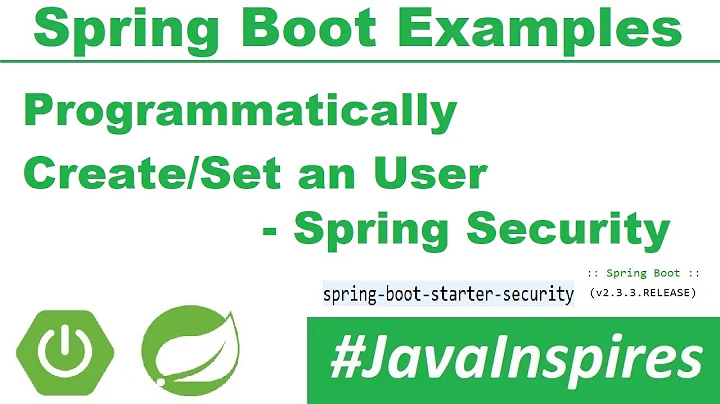How to login a user programmatically using Spring-security?
Solution 1
Unfortunately it seems there is no "complete" support of programmatic login in Spring security. Here is how I've done it successfully:
@Autowired AuthenticationSuccessHandler successHandler;
@Autowired AuthenticationManager authenticationManager;
@Autowired AuthenticationFailureHandler failureHandler;
public void login(HttpServletRequest request, HttpServletResponse response, String username, String password) {
UsernamePasswordAuthenticationToken token = new UsernamePasswordAuthenticationToken(username, password);
token.setDetails(new WebAuthenticationDetails(request));//if request is needed during authentication
Authentication auth;
try {
auth = authenticationManager.authenticate(token);
} catch (AuthenticationException e) {
//if failureHandler exists
try {
failureHandler.onAuthenticationFailure(request, response, e);
} catch (IOException | ServletException se) {
//ignore
}
throw e;
}
SecurityContext securityContext = SecurityContextHolder.getContext();
securityContext.setAuthentication(auth);
successHandler.onAuthenticationSuccess(request, response, auth);//if successHandler exists
//if user has a http session you need to save context in session for subsequent requests
HttpSession session = request.getSession(true);
session.setAttribute("SPRING_SECURITY_CONTEXT", securityContext);
}
UPDATE Essentially the same is done by Spring's RememberMeAuthenticationFilter.doFilter()
Solution 2
This code is from Grails' Spring Security Core -Plugin, which is released under the Apache 2.0 license. I've added the imports just to point out what the types are exactly. The original author is Burt Beckwith.
import org.springframework.security.core.userdetails.UserCache;
import org.springframework.security.core.userdetails.UserDetails;
import org.springframework.security.core.userdetails.UserDetailsService;
import org.springframework.security.core.context.SecurityContextHolder;
import org.springframework.security.authentication.UsernamePasswordAuthenticationToken;
...
public static void reauthenticate(final String username, final String password) {
UserDetailsService userDetailsService = getBean("userDetailsService");
UserCache userCache = getBean("userCache");
UserDetails userDetails = userDetailsService.loadUserByUsername(username);
SecurityContextHolder.getContext().setAuthentication(new UsernamePasswordAuthenticationToken(
userDetails, password == null ? userDetails.getPassword() : password, userDetails.getAuthorities()));
userCache.removeUserFromCache(username);
}
The getBean-method merely provides the bean from application context.
Related videos on Youtube
Jack
Updated on October 18, 2022Comments
-
Jack over 1 year
I need to programmatically login users that were authenticated through Facebook API. The reason for that is that there are number of items that are associated to each user (for example shopping cart), therefore once user is authenticated using Facebook API, I need to log the user in using spring security as well to be able to access his/her shopping cart.
Based on my research, there are many methods to implement it but I could not deploy any of them as I am sending log-in request from my code, also another problem is that some people created user object but they did not explain how to create it.
Those who created a user object but did not explain how.
From first example:this answer
Authentication auth = new UsernamePasswordAuthenticationToken(user, null, user.getAuthorities());From second example: this one
34.User details = new User(username); 35.token.setDetails(details);From third example: this one
Authentication authentication = new UsernamePasswordAuthenticationToken(user, null, AuthorityUtils.createAuthorityList("ROLE_USER"));Another example is here, it does not help because I need to log-in user from my own code not from browser; therefore I do not know how to populate HttpServletRequest object.
protected void automatedLogin(String username, String password, HttpServletRequest request) {MyCode
... if(isAuthenticatedByFB()) { login(username); return "success"; } else{ return "failed"; } -
Jack over 7 yearsThanks, would you please elaborate further. do I need any requestHandler for it? How to configure the project?
-
 Roman Sinyakov over 7 yearsI use the typical spring security configuration which is applied in processing HTTP requests as usual. Code above works in special cases when I need to authenticate the user internally.
Roman Sinyakov over 7 yearsI use the typical spring security configuration which is applied in processing HTTP requests as usual. Code above works in special cases when I need to authenticate the user internally. -
gstackoverflow almost 7 yearsHow to authtecicate using oauth 2.0 ?
-
Jay Edwards about 6 yearsPlease, where/how are you defining the
securityContextvariable supplied tosession.setAttribute(...)? -
 Roman Sinyakov about 6 years@JayEdwards thanks for the question, I fixed the code snippet
Roman Sinyakov about 6 years@JayEdwards thanks for the question, I fixed the code snippet -
Madbreaks over 5 yearsThe last two lines of that method (at least) are not thread safe. Instead do:
request.getSession(true).setAttribute("SPRING_SECURITY_CONTEXT", securityContext); -
Tobias Hagenbeek over 4 yearsso this actaully validates all passwords as true, even badones.
![[Spring Security] Login Logout Authorization](https://i.ytimg.com/vi/9B7Kpe8bq8M/hqdefault.jpg?sqp=-oaymwEcCOADEI4CSFXyq4qpAw4IARUAAIhCGAFwAcABBg==&rs=AOn4CLB50R9n2-yry9Jf1ca7ekjZOes98g)







![[Spring Boot Security] #19 Database Authentication - Implement User Details Service](https://i.ytimg.com/vi/TDuVY8PFU3Q/hq720.jpg?sqp=-oaymwEcCNAFEJQDSFXyq4qpAw4IARUAAIhCGAFwAcABBg==&rs=AOn4CLA36-RZvlC2kyK0IrhLu9x5q9ZLig)

